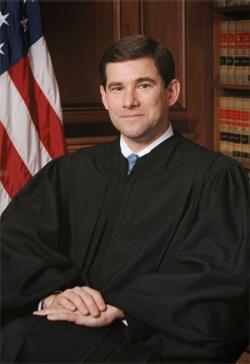On Wednesday, Donald Trump released a list of judges he might nominate to the Supreme Court, should he win the presidency. Predictably, the list was packed with reactionary conservatives who would likely use their position to advance the Republican Party’s agenda from the bench. I initially included Judge William Pryor, a George W. Bush appointee on the 11th Circuit, in that group; Pryor has, after all, issued rulings against contraceptive coverage and clean election laws.
But as ACLU attorney Daniel Tilley pointed out to me, Pryor also has one strikingly liberal case under his belt: He supported an absolutely revolutionary opinion in 2011 holding that anti-trans discrimination qualifies as sex discrimination and is thus generally forbidden under the Equal Protection Clause of the U.S. Constitution. Pryor didn’t write the decision—it was authored by Pryor’s 11th Circuit colleague Judge Rosemary Barkett, a liberal firebrand—but he did join it in full, suggesting he endorsed its logic and conclusion. If that’s true, then Pryor, as a Supreme Court justice, would be almost certain to invalidate the recent spate of anti-trans legislation, including North Carolina’s odious bathroom bill.
The case, Glenn v. Brumby, involved a dispute between Elizabeth Glenn, an editor at the Georgia General Assembly’s Office of Legislative Counsel, and her boss, Sewell Brumby. Glenn is trans and began transitioning in 2006. When she began wearing women’s clothing, Brumby said her appearance was “inappropriate” because she was “a man dressed as a woman and made up as a woman.” Brumby insisted that Glenn’s transition was “unnatural,” and stated that “it’s unsettling to think of someone dressed in women’s clothing with male sexual organs inside that clothing.” Soon after, Brumby directed Glenn’s supervisor to fire her, because “Glenn’s intended gender transition … would be disruptive,” “people would view it as a moral issue,” and “it would make Glenn’s coworkers uncomfortable.”
Glenn sued Brumby, alleging that his adverse actions violated the Equal Protection Clause, which typically prohibits states from engaging in sex discrimination. She argued that Brumby had “discriminat[ed] against her because of her sex, including her female gender identity and her failure to conform to the sex stereotypes associated with the sex [that the defendant] perceived her to be.” A three-judge panel on the 11th Circuit—comprised of Pryor, Barkett, and Judge Phyllis Kravitch—unanimously agreed with Glenn. The Supreme Court, Barkett noted in her opinion, has found that sex stereotyping—mistreating an individual because she is not “feminine” enough, for instance—is a form of sex discrimination. Barkett then explained:
A person is defined as transgender precisely because of the perception that his or her behavior transgresses gender stereotypes. “[T]he very acts that define transgender people as transgender are those that contradict stereotypes of gender-appropriate appearance and behavior.” … There is thus a congruence between discriminating against transgender and transsexual individuals and discrimination on the basis of gender-based behavioral norms.
Accordingly, discrimination against a transgender individual because of her gender-nonconformity is sex discrimination, whether it’s described as being on the basis of sex or gender. … An individual cannot be punished because of his or her perceived gender-nonconformity. Because these protections are afforded to everyone, they cannot be denied to a transgender individual. The nature of the discrimination is the same; it may differ in degree but not in kind, and discrimination on this basis is a form of sex-based discrimination that is subject to heightened scrutiny under the Equal Protection Clause.
Barkett then listed nearly a dozen federal cases that likewise found that anti-trans discrimination constituted “sex discrimination” in a variety of contexts. She also noted that “ever since the Supreme Court began to apply heightened scrutiny to sex-based classifications, its consistent purpose has been to eliminate discrimination on the basis of gender stereotypes.” Expanding a ban on sex discrimination to anti-trans discrimination isn’t a stretch; it’s a logical conclusion. From the Supreme Court’s earliest sex discrimination cases, the justices have found that “governmental acts based upon gender stereotypes—which presume that men and women’s appearance and behavior will be determined by their sex—must be subjected to heightened scrutiny because they embody ‘the very stereotype the law condemns.’ ” Discrimination against trans people for not fitting into some prescribed gender role is, quite literally, discrimination because of sex.
Glenn v. Brumby was not the first federal ruling to explicitly hold that the Equal Protection Clause protects trans people—but it has been one of the most influential. Part of its importance is its unanimity: There were no dissenters, no angry naysayers attempting to undermine the court’s airtight logic. And Pryor’s decision to fully join Barkett’s opinion gave the ruling a sheen of bipartisanship. Pryor may be severely conservative in other areas of the law. But on the topic of trans rights—the chief legal issue facing the LGBTQ community today—Pryor sounds like a true progressive.
